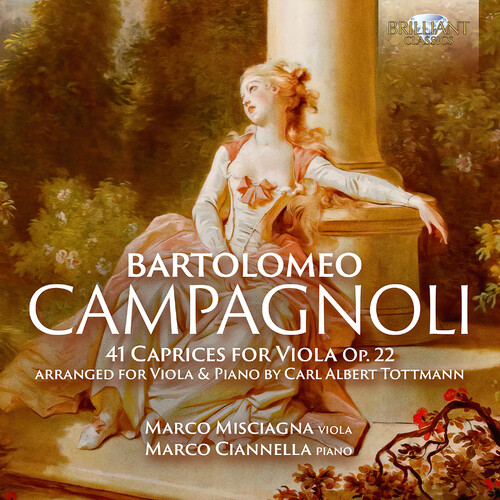Show results for
Deals
- 4K Ultra HD Sale
- 50s Films Sale
- Action Sale
- Alternative Rock Sale
- Anime sale
- Award Winners Sale
- Bear Family Sale
- Blu ray Sale
- Blues on Sale
- British Sale
- Christmas in July
- Classical Music Sale
- Comedy Music Sale
- Comedy Sale
- Country Sale
- Criterion Sale
- Electronic Music sale
- Folk Music Sale
- Horror Sci fi Sale
- Kids and Family Sale
- Metal Sale
- Music Video Sale
- Musicals on Sale
- Mystery Sale
- Naxos Label Sale
- Page to Screen Sale
- Paramount Sale
- Rap and Hip Hop Sale
- Reggae Sale
- Rock
- Rock and Pop Sale
- Rock Legends
- Soul Music Sale
- TV Sale
- Vinyl on Sale
- War Films and Westerns on Sale

41 Caprices for Viola Op.22 arranged for Viola & Piano by Carl
- Format: CD
- Release Date: 11/18/2022

41 Caprices for Viola Op.22 arranged for Viola & Piano by Carl
- Format: CD
- Release Date: 11/18/2022
- Composers: Bartolomeo Campagnoli
- Label: Brilliant Classics
- Number of Discs: 2
- UPC: 5028421965512
- Item #: 2525762X
- Genre: Classical
- Release Date: 11/18/2022

Product Notes
The considerable fame that Bartolomeo Campagnoli (1751-1827) achieved during his own lifetime was largely due to his contribution to violin studies. The 41 Caprices he wrote for viola and the 7 Divertimenti for solo violin are still in use today. Campagnoli's career as a concert performer began in Rome in 1775, continuing in a long tour of the courts of the capital cities of Europe. In 1797 he was made concert director and first violin at the Gewandhaus in Leipzig, a post that he held until 1818, although he also maintained his contacts with the most advanced and influential cultural centers of Europe. He thus enjoyed a florid exchange with some of the most famous teachers and Nevertheless, there is an unmistakably composers of the time, in particular with Cherubini and Kreutzer. The idea that 'true expression depends on the sound, intonation, movement, taste and aplomb of the measure' was a constant tenet with Campagnoli, as was his insistence on the need to understand clearly the character of each piece in order to appreciate to the full the composer's intentions. All this required respect for the exact point in which embellishments have to be added (without exceeding), because: 'nothing is more beautiful and moving than what is simple'.

